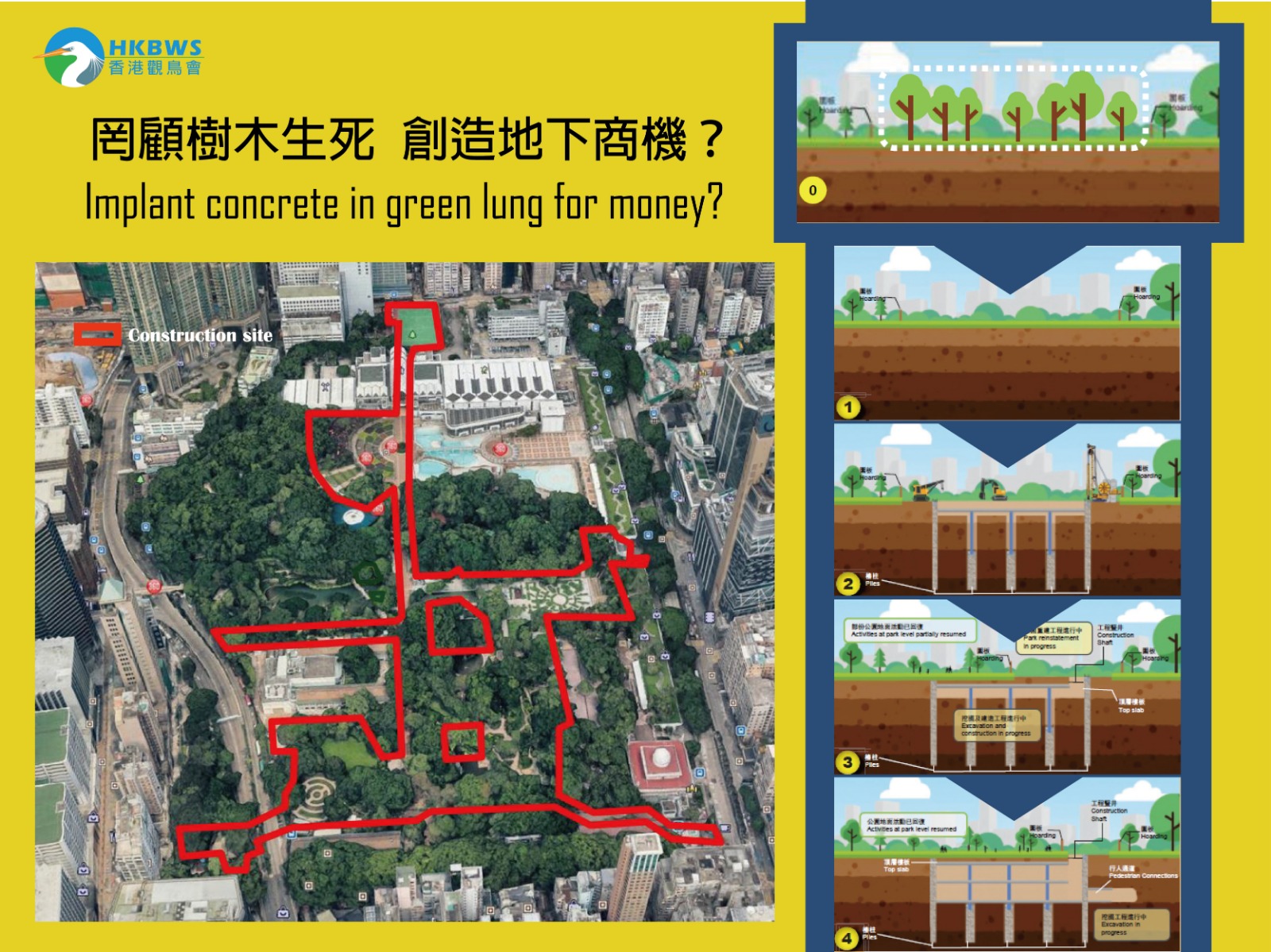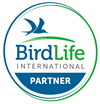
| HKBWS's Comments on the Stage 2 Public Engagement Digest for Underground Space Development in Selected Strategic Urban Areas |
After the Stage 1 Public Engagement, Kowloon Park was selected among the four strategic urban areas to develop its underground space with priority. Kowloon Park is a green lung in the urban area and an urban refuge for wildlife. However, the proposed large scale underground development would bring undesirable ecological damage to this public amenity. The conceptual scheme is in fact an underground shopping mall with carpark accounting for 60% of the total underground space, while only about 15.6% is proposed for community facilities and public space. It is unacceptable to diminish the ecological, social and amenity value of Kowloon Park for generating commercial value. The Hong Kong Bird Watching Society (HKBWS), therefore, would like to object to the underground development at Kowloon Park based on the following reasons.
Ecological and social values of Kowloon Park
Kowloon Park is located at the heart of the Kowloon Peninsula. With many old trees, extensive interconnected tree canopies and slightly elevated from the street level, the park creates tranquility within the hustle and bustle of the city. From an ecological perspective, Kowloon Park is a green lung in the urban area and an urban refuge for wildlife.
The egretry at Kowloon Park is the seventh largest colony among 21 colonies in Hong Kong in 2018. Kowloon Park consists of a total of 48 nests in Hong Kong [1] . This colony supports about 26% of the total number of nests of Black-crowned Night Heron (Nycticorax nycticorax) in Hong Kong. Therefore, the Kowloon Park egretry is an important egretry in Hong Kong and should be considered as “an important ecological habitat”.
In 2018, Black-crowned Night Heron (Nycticorax nycticorax), that is the only species nest and breed at the egretry in Kowloon Park, is regarded as of “Local Concern” which is assessed based on the restrictedness in their nesting and/or roosting sites [2]. We thus consider they are bird species of conservation interest especially at their nesting and roosting sites. Yet, the egretry is at the immediate vicinity of the selected site for underground space development, hence the potential impacts on the birds should not be overlooked.
Moreover, Kowloon Park provides suitable habitats for both residents and migratory birds. According to HKBWS bird records, migratory bird species of conservation concern recorded in Kowloon Park include the globally near threatened Japanese Paradise Flycatcher [3] , Ferruginous Flycatcher (Muscicapa ferruginea) of potential regional concern [4], and Orange-headed Thrush (Geokichla citrina) of local concern [4]. The nationally rare and protected Crested Goshawk (Accipiter trivirgatus) was recorded breeding in the park. Other woodland associated migratory bird species such as Narcissus Flycatcher (Ficedula narcissina), Mugimaki Flycatcher (Ficedula mugimaki), Grey-streaked Flycatcher (Muscicapa griseisticta) and Blue-and-white Flycatcher (Cyanoptila cyanomelana) were recorded in the park as well. We consider that the trees in Kowloon Park are suitable and important foraging/roosting grounds for birds.
As such, Kowloon Park is a popular birding place given its proximity to the city centre and its diverse bird life. HKBWS regularly holds birdwatching activities in the park every Friday morning, where visitors can enjoy the bird life together with the Society’s experienced members [5]. Kowloon Park is also one of the four sites selected for our elementary bird watching course field trips. In 2016 and 2017, we held our Sparrow Carnival in the Kowloon Park Piazza. The location is ideal to promote and educate the public about nature in urban areas, and allow them to experience the bird life within the park.
Direct habitat loss aroused from the proposed scale of development
From the public engagement digest Stage 1 and 2, it is repeatedly stated that Old and Valuable Trees (OVT) and densely vegetated areas would be excluded from the underground development by setting aside a buffering distance. As the root system of these trees in the park can be extensive, referring to both spread and depth, it is necessary to understand the root system prior to the planning stage. However, there is no information provided in both consultation papers to investigate the root system of the OVT in Kowloon Park, so as to demonstrate how the proposed construction area could protect the OVT against any potential adverse impacts.
Apart from the concerns about OVT, we consider that all other trees in the park are important for birds and should be adequately protected. All the aboveground and underground works of the development should not damage the canopies and root systems of the trees.
However, from the paper of Pilot Study on Underground Space Development in Selected Strategic Urban Areas – Stage 2 Public Engagement Digest (the paper), surface excavation would be carried out for the construction of underground space (Figure 1). From Google Earth aerial photograph, most of the excavation site, which is about approximately 33,250 square metre and accounting for 25% of Kowloon Park area, is currently covered with tall trees (Figure 2). It is also mentioned in the Focus Group Meeting held on 5 June 2019 that there would be 300 trees affected under the proposed surface excavation works. We are concerned the underground works required may directly or indirectly damage the tree root systems and adversely affect the health and survival of these trees, which may in turn disturb the roosting and foraging grounds for birds.
“Top-down” construction method as a measure to minimize impacts is misleading
From the paper, the “top-down” construction technology is claimed “to minimize possible disruption to Kowloon Park” as compared to the conventional “bottom-up” construction. They emphasized that the current proposal would allow “early commencement if reinstatement works for the affected surface and resume part of the park activities while the underground excavation activities can continue”, and therefore the ‘disruption to the park could be lessened by “top-down” approach’ [6].
However, as mentioned in the previous section, the extensive surface excavation associated from the proposed“Top-down” construction method which will be associated with an extensive vegetation clearance and removal of trees, will cause serious disruption to the ecology of the park. Even if there is transplantation of some of the affected trees, the health of the tree is greatly compromised during the process and there is no guarantee that all tree individuals will healthily survive after the transplantation. We consider in-situ conservation should be regarded as the first priority whereas transplantation should be regarded as last resort for mitigation measure.
Moreover, the four diagrams at page 23 of the paper showing the construction procedures of the proposed “top-down” approach only illustrate the process of turning a “grassland” to a land covered with trees, giving the public a false impression that the proposed project will plant more trees in Kowloon Park and enhance its aesthetic value. This is misleading as the current status of the well-wooded Kowloon Park was not shown, while the works required to reach the “grassland” appearance in the first diagram (i.e. tree removal/ transplantation, site clearance and erection of hoardings) were hidden. (Figure 1)
Without mentioning the direct habitat loss resulted from the proposed “technology”, we consider that claiming the “top-down” approach could minimize the impacts by simply comparing it with the “bottom-up” approach is misleading. The proposed so-called “top-down” construction method is simply destructive to both the ecology and amenity of the park due to the massive surface excavation works.
Potential adverse impacts on bird life
The construction site is just 25m distance from the egretry. Given that breeding egrets/herons are susceptible to disturbance by human activities, we are concerned the construction of the underground space would greatly increase the disturbance from the lighting, human activities and noise to the egretry, thus deteriorate the habitat quality and potentially reduce the breeding success of the birds. In the worst case scenario, the egrets may eventually abandoned the site and may have adverse impacts on the viability of the egret/heron population. However, there is no measure proposed by the project proponent to avoid the potential undesirable impacts on the breeding egrets/herons.
Moreover, we are concerned the entrances/exits of the underground space created within Kowloon Park would change the visitor flow, thus may disrupt the tranquility of the park and create more disturbances to the birds and their habitats. The construction and operation of the proposed underground development may alter the composition of birds in the park and adversely affect the habitat quality for the birds to roost and forage.
The proposed underground space is not in line with the planning intention of “Open Space (O)” zoning
According to the Approved Tsim Sha Tsui Outline Zoning Plan No. S/K1/28 , the proposed development is located within O zoning where is “intended primarily for the provision of outdoor public open-air space for active and/or passive recreational uses serving the needs of local residents as well as the general public.” Moreover, it is stated in the explanatory statement that “Kowloon Park is a large public open space which has district significance.”[7]
Public space is considered as the main feature to be provided by parks like Kowloon Park under O zoning. However, the proposed underground development provides only about 15.6% of underground space for community facilities and public space, while 60% of them are for commercial uses including retail/food and beverage facilities and parking facilities.
Such commercial-intensive development will not only undermine the “district significance” of embracing such a high ecological and social value in urban area due to the damaging construction works, but it is also not in line with the intention to provide public space for the residents and public.
[1] Anon, 2018. Summer 2018 Report: Egretry Counts in Hong Kong with particular reference to the Mai Po Inner Deep Bay Ramsar Site. Report by The Hong Kong Bird Watching Society to the Agriculture, Fisheries and Conservation Department, Hong Kong Special Administrative Region Government.
[2] Fellowes et al.: Fauna of Conservation Concern (2002)
[3] http://www.iucnredlist.org/details/22707151/0
[4] Fellowes et al. 2002
[5] http://www.lcsd.gov.hk/en/parks/kp/watching.html
[6] Stage 2 Public Engagement Digest. Available at: https://www.urbanunderground.gov.hk/files/docs/Stage2_Digest.pdf
[7] Approved Tsim Sha Tsui Outline Zoning Plan No. S/K1/28. Available at:
https://www2.ozp.tpb.gov.hk/plan/ozp_plan_notes/en/S_K1_28_e.pdf
| HKBWS's Comments on the Stage 2 Public Engagement Digest for Underground Space Development in Selected Strategic Urban Areas |
Let’s take a look at the development proposal and take action to express your view before 21 August 2019!
Official Website for Stage 2 Public Engagement: https://www.urbanunderground.gov.hk/public_engagement2.php?locale=en



